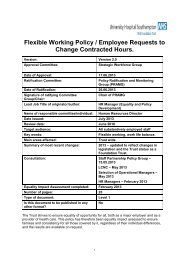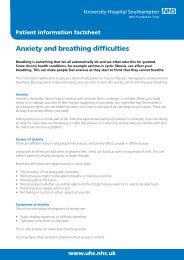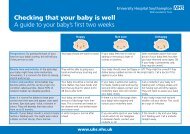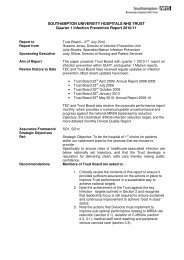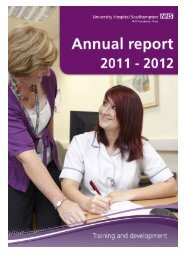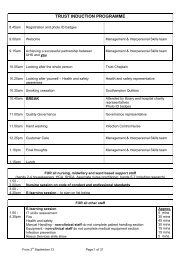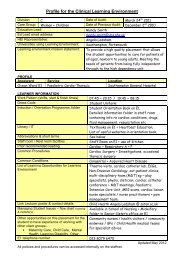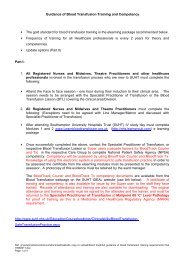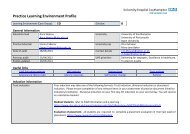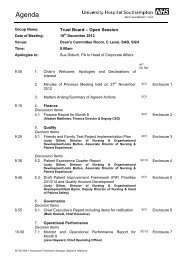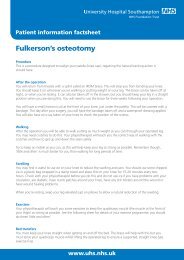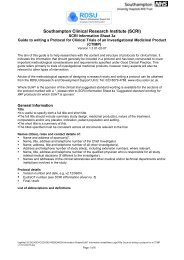“The Development <strong>of</strong> the Child Psychiatry and Child Guidance Service inHampshire” by Dr Mary Capes.Introduction.These recollections stretch back over a period <strong>of</strong> more than 50 <strong>years</strong> and are inevitably a bit hazy but an attempt hasbeen made to describe the start <strong>of</strong> the Child Psychiatric and Child Guidance Services in the Region, how they developedas a result <strong>of</strong> war-time demands, and how this led to the establishment <strong>of</strong> a comprehensive <strong>service</strong> with particularreference to the set up which evolved in the <strong>Southampton</strong> Children’s <strong>Hospital</strong>.General Background.Training in Child Psychiatry with it’s special emphasis on team work with educational psychologists and psychiatric socialworkers first became possible in the twenties at the London Child Guidance Training Centre funded in the beginninglargely by the Commonwealth Centre <strong>of</strong> the U.S.A. Paediatricians, until the mid-forties, had to receive their training in theU.S.A. so the American influence at the time was strong in both newly fledged disciplines. Child psychiatry at first (ratherlike the young cuckoo in it’s varied nests) could be established as part <strong>of</strong> a Mental Treatment Dept as it was inPortsmouth in 1937, or in clinics, generally known as Child Guidance Clinics (on the American pattern), which werebeginning to be set up by Local Authorities, as in <strong>Southampton</strong>, which also was first established in 1937. There were noother such facilities in the Wessex Region and with the outbreak <strong>of</strong> hostilities in 1939 even the <strong>Southampton</strong> clinic wasclosed and Dr Sybil Yates, who ran it, took an appointment elsewhere.However with the outbreak <strong>of</strong> World War II and the expectation <strong>of</strong> heavy bombing, children were evacuatedfrom the cities to the countryside in large numbers coming to Hampshire from Portsmouth and <strong>Southampton</strong> as well asfrom London and, as billetting <strong>of</strong>ficers became increasingly aware <strong>of</strong> the numbers <strong>of</strong> children who failed to settle happilyin their foster homes and were disturbed by the experience, they demanded help from the Hampshire County MedicalOfficer. He contacted the Mental Health Emergency Committee (based in Reading) and they advised the appointment <strong>of</strong>a psychiatric social worker and Miss Marion Opie took on the job. She visited the hostels, mostly in sizeable privatehouses which had been commandeered, and which housed children who were difficult to billet in foster homes, and itsoon became evident to her that the help <strong>of</strong> a child psychiatrist and an educational psychologist was also needed. I wasapproached, and it made sense to transfer my work from Portsmouth to Hampshire, which I did in 1942 in company withMiss Wills, an educational psychologist. The gap left in Portsmouth was filled during the war <strong>years</strong> by Dr Mildred Creak <strong>of</strong>Great Ormond Street <strong>Hospital</strong>, who worked there part-time. She also succeeded in setting up a small in-patient unit at StJames Mental <strong>Hospital</strong>Over in Hampshire we were <strong>of</strong>fered two attic rooms in the Castle, Winchester as our H.Q. and we proceeded to build up 9centres for diagnostic and treatment purposes scattered throughout the County - these were, apart from Winchester(where two Portsmouth Grammar schools were billeted), at Romsey, Basingstoke, Kingsclere, Highclere Castle (with thetoddler evacuees without mothers!), Totton, Lyndhurst, Petersfield and Clanfield. These centres, which were attendedabout once a fortnight, were either based on hostels or were at ordinary school clinics.Over the <strong>years</strong> from 1942-46 the evacuee population steadily decreased but G.P,s, teachers and social workers hadbecome familiar with the <strong>service</strong> and were beginning to refer local children. By the end <strong>of</strong> World War II the clinics hadreally become permanent fixtures, organised by the L.A. The war-time conditions had given a great impetus to ChildPsychiatric and C.G. work, speedy decisions and flexibility were called for too and the experience gained <strong>of</strong> disturbedchildren being admitted to short-term residential centres proved invaluable. In the past, in the more extreme cases, theonly placement for such children had been in the adult wards <strong>of</strong> Mental <strong>Hospital</strong>s, which was clearly undesirable, but noalternative presented itself.By 1948 the <strong>Southampton</strong> authority decided to open their C,G. clinic again and invited me to run it - which invitation Iaccepted in the hope that commitments would be less in a Borough than in a County. Just after this, still in 1948, andmuch more important, the National Health Service was established, and doctors came under contracts to RegionalBoards, with their futures more secure. In our region we were supervised by the South West Metropolitan <strong>Hospital</strong> Board,with the late Sir John Revans as our dynamic and supportive Senior Administrative Medical Officer. The late Pr<strong>of</strong> Sir AlanMoncrieff, taking advantage <strong>of</strong> new N.H.S. possibilities wrote to all the children’s hospitals and paediatric units in the U.K.at that time advising the appointment <strong>of</strong> a Child Psychiatrist to the staff wherever possible, <strong>Southampton</strong> Children’s<strong>Hospital</strong> was sympathetic to this proposal: the post was advertised on a part-time basis and I was appointed late in 1948,with continuing responsibility for the L.A. clinic as well.The Childrens <strong>Hospital</strong>.
This appointment although it was good to be back in the medical field, involved me once more in an entirely new method<strong>of</strong> working: I was as it were out on a limb, the premises being much too limited to house a team. If the children I wasasked to see lived in the Borough, it was possible to refer them on for full investigation and, if necessary, prolongedtreatment at the Health Centre, but for children from the County a flexible and modified type <strong>of</strong> treatment was <strong>of</strong>tennecessary. There was also considerable difficulty in the use <strong>of</strong> beds; if one wanted to admit a patient whenever beds werein short supply my patients understandably, had to make way for emergencies however disruptive it might be to them.This ceased to be a problem when in 1952, Dr Christopher Haffner was appointed to Portsmouth to plan and operate aspecial unit with in-patient and out- patient facilities for disturbed children and their parents. These points apart, much thatwas interesting and experimental was tried out at the hospital, largely initiated as a result <strong>of</strong> the co-operative attitude <strong>of</strong>the paediatricians. A joint round took place regularly at Bursledon when I accompanied Dr Williamson, and also a monthlypsychosomatic clinic was held by both <strong>of</strong> us and, largely owing to the fact that the two out—patient consulting rooms hadan intercommunicating door, a child could be given an (almost) immediate psychiatric interview at the paediatrician’srequest, or be seen by both consultants togethe, thus saving a second journey for long-distance travellers.Possibly most interesting <strong>of</strong> all the combined activities was the presentation <strong>of</strong> cases from time to time at the monthlyclinical meetings when G.P.s, young doctors and nurses attending could be given some further insight into psychologicalproblems and their treatabilityTeenagers were not seen at the Children’s <strong>Hospital</strong> beyond the age <strong>of</strong> 16, and there were fewer referrals in this agegroup but they were <strong>of</strong>ten considerably disturbed. When in-patient treatment seemed advisable they were admitted toLeigh House in Chandlers Ford. This was a special unit for adolescents which the Regional Board had set up when thebuilding became available (it was previously used for treating women with TB.). Dr W. Allchin and Dr Rosenberg wereappointed in 1961 to run the unit which was conveniently near to <strong>Southampton</strong> and Winchester.It became noticeable as the <strong>years</strong> passed that more girls than boys were referred to the Children’s <strong>Hospital</strong>, mainlysuffering from psychosomatic disorders such as feeding problems, asthma and anxiety states whereas more boys, manypresenting with behaviour disorders, were referred to the L.A. Child Guidance Centre, a number coming from the JuvenileCourt, thereby indicating a need for both types <strong>of</strong> facility since behaviour problems would be largely inappropriate seen ina hospital settingVisitingThe whole question <strong>of</strong> children being visited by their families and <strong>of</strong> infants and toddlers being accompanied into hospitalby their mothers was coming under public discussion at the time <strong>of</strong> my appointment. The late Sir James Spence hadreported in 1946 on his Babies <strong>Hospital</strong> where he had had twenty <strong>years</strong> experience <strong>of</strong> admitting mothers as well, and Drand Mrs Pickerill in New Zealand reported very favourably on their plastic surgery unit where they had admitted mothersto counter cross infection. They had found this beneficial in a number <strong>of</strong> ways. These reports coupled with the research <strong>of</strong>Dr John Bowlby on separation anxiety and the late James Robertson into the emotional after effects <strong>of</strong> hospitaladmission, which were in their initial stages, seemed to make a lot <strong>of</strong> sense. I raised both the issue <strong>of</strong> visiting and <strong>of</strong>mother’s being admitted fairly soon after being appointed, appreciating that there would be great difficulty in achieving thelatter owing to the very limited space in the hospital, but the former was discussed at a number <strong>of</strong> medical committeemeetings. Dr Ormiston, who was the first paediatrician to be appointed to the staff in 1947, had come fresh from theU.S.A. and was seriously worried about the degree <strong>of</strong> infection and the high mortality rate in the wards and wasunderstandably apprehensive about any infection being introduced from the outside world. It was finally decided by MrRichardson, the Children’s Surgeon, who was Chairman <strong>of</strong> the committee, that a vote should be taken, which resulted inan equal number <strong>of</strong> votes for and against, leaving him to cast his vote – in favour. At first the visiting was somewhatrestricted but as the worst fears failed to be realised the rules became increasingly relaxed. Some doctors found thevirtual pandemonium after the subdued atmosphere in the wards difficult to take but not the children! I must say thatthough these discussions involved strongly held opinions, the final outcome was accepted without the least acrimony.Several <strong>years</strong> later in 1959, two rooms were set aside so that some mothers, eventually, were able to come into thehospital with their children.It might be <strong>of</strong> interest in this context to make a brief reference to a W.H.O.study group. Dr Begg the medical director <strong>of</strong> theEuropean Office asked me, in 1951, to organise a small conference or study group on the care <strong>of</strong> children in hospitalwhich was to include the respective roles <strong>of</strong> paediatricians and child psychiatrists, the coordination <strong>of</strong> their work and theinter-relation <strong>of</strong> somatic and psychological processes in sick children. The meeting took place in Stockholm where it washosted by Pr<strong>of</strong> Wallgren <strong>of</strong> the Children’s Clinic at the Karolinska <strong>Hospital</strong>, with Sir Alan Moncrieff chairing the clinicalproceedings. The Paediatricians and Child Psychiatrists who presented these had had experience in close cooperationtogether and included Dr R. Bonham-Carter and Dr Soddy from UCH. London, Pr<strong>of</strong> Milton Senn and Dr Solnit from theU.S.A. and two pairs <strong>of</strong> Swedish doctors,and the delegates were largely drawn from Scandinavian Countries. It was alively and useful meeting and in 1955 a report entitled “The Child in <strong>Hospital</strong>” was published by WHO, and was widelydistributed.As a final thought I look back with pleasure at the memory <strong>of</strong> the murals in the anaesthetic room at the Children’s <strong>Hospital</strong>which were painted by Miss M. Wilson, a Winchester artist. These made a rather bare and forbidding room into anattractive one and the children enjoyed counting the colourful balloons as they gradually lost consciousness,



